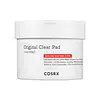What's inside
What's inside
 Key Ingredients
Key Ingredients

 Benefits
Benefits

 Concerns
Concerns

 Ingredients Side-by-side
Ingredients Side-by-side

Water
Skin ConditioningOenanthe Javanica Extract
AntimicrobialButylene Glycol
Humectant1,2-Hexanediol
Skin ConditioningDipropylene Glycol
HumectantCitrus Junos Fruit Extract
Skin ConditioningPanthenol
Skin ConditioningPPG-13-Decyltetradeceth-24
EmulsifyingBetaine
HumectantEthylhexylglycerin
Skin ConditioningFicus Carica Fruit Extract
HumectantAllantoin
Skin ConditioningGlycerin
HumectantPropanediol
SolventDiphenyl Dimethicone
EmollientTriethylhexanoin
MaskingCapryloyl Salicylic Acid
ExfoliatingCentella Asiatica Extract
CleansingSodium Citrate
BufferingSalvia Officinalis Leaf Extract
CleansingChamomilla Recutita Extract
Skin ConditioningDipotassium Glycyrrhizate
HumectantSodium Phytate
Polyglyceryl-10 Oleate
Skin ConditioningHydrogenated Lecithin
EmulsifyingSodium Hyaluronate
HumectantPhospholipids
Skin ConditioningRhodomyrtus Tomentosa Fruit Extract
HumectantEucalyptus Globulus Leaf Oil
PerfumingLeuconostoc/Radish Root Ferment Filtrate
AntimicrobialCitrus Aurantium Bergamia Fruit Oil
MaskingHelianthus Annuus Seed Oil
EmollientPantothenic Acid
Skin ConditioningSalvianolic Acid B
Skin ConditioningWater, Oenanthe Javanica Extract, Butylene Glycol, 1,2-Hexanediol, Dipropylene Glycol, Citrus Junos Fruit Extract, Panthenol, PPG-13-Decyltetradeceth-24, Betaine, Ethylhexylglycerin, Ficus Carica Fruit Extract, Allantoin, Glycerin, Propanediol, Diphenyl Dimethicone, Triethylhexanoin, Capryloyl Salicylic Acid, Centella Asiatica Extract, Sodium Citrate, Salvia Officinalis Leaf Extract, Chamomilla Recutita Extract, Dipotassium Glycyrrhizate, Sodium Phytate, Polyglyceryl-10 Oleate, Hydrogenated Lecithin, Sodium Hyaluronate, Phospholipids, Rhodomyrtus Tomentosa Fruit Extract, Eucalyptus Globulus Leaf Oil, Leuconostoc/Radish Root Ferment Filtrate, Citrus Aurantium Bergamia Fruit Oil, Helianthus Annuus Seed Oil, Pantothenic Acid, Salvianolic Acid B
 Reviews
Reviews

Ingredients Explained
These ingredients are found in both products.
Ingredients higher up in an ingredient list are typically present in a larger amount.
1,2-Hexanediol is a synthetic liquid and another multi-functional powerhouse.
It is a:
- Humectant, drawing moisture into the skin
- Emollient, helping to soften skin
- Solvent, dispersing and stabilizing formulas
- Preservative booster, enhancing the antimicrobial activity of other preservatives
Allantoin is a soothing ingredient known for its protective and moisturizingg properties. Because of this, it is often added to products with strong active ingredients.
Studies show higher concentrations of this ingredient can promote wound healing.
Though it can be derived from the comfrey plant, allantoin is produced synthetically for cosmetic products to ensure purity.
Learn more about AllantoinButylene Glycol (or BG) is used within cosmetic products for a few different reasons:
Overall, Butylene Glycol is a safe and well-rounded ingredient that works well with other ingredients.
Though this ingredient works well with most skin types, some people with sensitive skin may experience a reaction such as allergic rashes, closed comedones, or itchiness.
Learn more about Butylene GlycolGlycerin is already naturally found in your skin. It helps moisturize and protect your skin.
A study from 2016 found glycerin to be more effective as a humectant than AHAs and hyaluronic acid.
As a humectant, it helps the skin stay hydrated by pulling moisture to your skin. The low molecular weight of glycerin allows it to pull moisture into the deeper layers of your skin.
Hydrated skin improves your skin barrier; Your skin barrier helps protect against irritants and bacteria.
Glycerin has also been found to have antimicrobial and antiviral properties. Due to these properties, glycerin is often used in wound and burn treatments.
In cosmetics, glycerin is usually derived from plants such as soybean or palm. However, it can also be sourced from animals, such as tallow or animal fat.
This ingredient is organic, colorless, odorless, and non-toxic.
Glycerin is the name for this ingredient in American English. British English uses Glycerol/Glycerine.
Learn more about GlycerinPanthenol is a common ingredient that helps hydrate and soothe the skin. It is found naturally in our skin and hair.
There are two forms of panthenol: D and L.
D-panthenol is also known as dexpanthenol. Most cosmetics use dexpanthenol or a mixture of D and L-panthenol.
Panthenol is famous due to its ability to go deeper into the skin's layers. Using this ingredient has numerous pros (and no cons):
Like hyaluronic acid, panthenol is a humectant. Humectants are able to bind and hold large amounts of water to keep skin hydrated.
This ingredient works well for wound healing. It works by increasing tissue in the wound and helps close open wounds.
Once oxidized, panthenol converts to pantothenic acid. Panthothenic acid is found in all living cells.
This ingredient is also referred to as pro-vitamin B5.
Learn more about PanthenolSodium Hyaluronate is hyaluronic acid's salt form. It is commonly derived from the sodium salt of hyaluronic acid.
Like hyaluronic acid, it is great at holding water and acts as a humectant. This makes it a great skin hydrating ingredient.
Sodium Hyaluronate is naturally occurring in our bodies and is mostly found in eye fluid and joints.
These are some other common types of Hyaluronic Acid:
Learn more about Sodium Hyaluronate